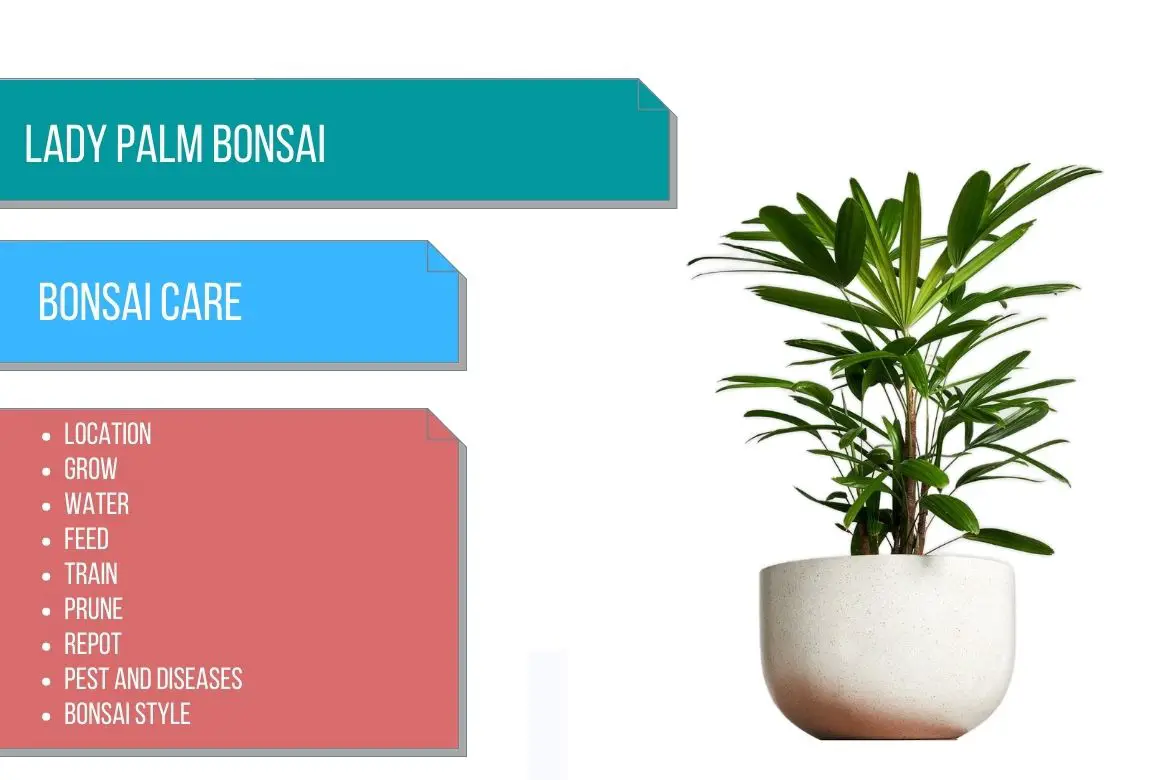
Lady palm / Hemp palm / Little lady palm / Slender lady palm
( Rhapis humilis excelsa )
Country of Origin : Japan, China
Bonsai Styles : Informal upright, group
Zone : 9 – 11
Lady palm (also known as bamboo palm) is a broad-leaf member of the palm tree family that grows naturally in tropical and subtropical environments.
It grows individual palm fronds with narrow spikes on bamboo-like stalks.
There is a net of dark, fibrous leaf sheaths covering the trunks. Dark green leaves form a fan-like shape.
The stems of the tree are thin, have an upright growth habit and they branch at the base. A fibrous sheath covers the sturdy stems of lady palm trees.
Each of the fan-shaped, glossy green fronds on the stem has between five and eight narrow, lance-shaped segments.
These trees are very slow growers and are extremely tolerant of low light levels. Because of these characteristics, the lady palm is a great specimen for indoor bonsai trees.
Best location to keep Lady palm tree Bonsai
Bonsai containers should be kept away from direct sunlight but in a fairly bright spot.
It is tolerant of tropical and subtropical temperatures between 20°F to 100°F (-6°C to 37°C), and also thrives in humid and dry climates.
The hemp palm bonsai tree is fairly cold hardy. However, do not expose the tree to a temperature below 50°F (10°C).
Keep out of cold drafts as well.
Despite being able to remain in the house all year long without harm, Rhapis bonsai will still enjoy periods of some fresh air outside during the summer.
IMP: Refer sunlight requirements for indoor plants for more indoor gardening ideas. Also, refer to do bonsai trees need sunlight for more indoor and outdoor bonsai location ideas.
Propagation of Lady palm tree
Lady palm can be propagated using seeds or rhizomes, root division.
They also produce shoots from the rhizomes. You can either take root divisions or even rhizomes. Be careful as these plants don’t appreciate a lot of root handling.
While using seeds, plant the seeds in a pot and keep the pot in a warm location ( 80ºF (26ºC)). Water the pot.
The germination should happen within 3-4 weeks.
Watering Lady palm tree Bonsai
Ensure that the bonsai soil is moist at all times, but not saturated.
Watering can be reduced in the winter if the plant is kept cool.
You should never let a hemp palm stand in water, but a light misting once or twice a week will do just fine.
Read watering bonsai tree for more details.
Wiring Lady palm tree Bonsai
Wiring of little lady palm tree is not required.
Pruning Lady palm tree Bonsai
When to prune Lady palm tree bonsai?
How to prune Lady palm tree bonsai?
Pruning a lady palm bonsai tree is not very tricky.
It is only necessary to prune the trees on an occasional basis.
This plant wont branch and if it reaches a height that is higher than you want it to be, you should prune it back to a frond.
Remove old and brown leaves.
Repotting Lady palm tree Bonsai
When to repot Lady palm tree bonsai?
The lady palm bonsai tree should be repotted as little as possible since palms do not enjoy their roots being messed with.
Nonetheless, it is important to repot in early spring when it becomes necessary. (in case the roots are pot bound).
It is important to give bottom heat after root pruning in order to encourage the formation of fresh roots.
In case you wish to increase the size of the tree, then choose a bigger bonsai container.
Make sure the soil you use is free-draining.
You can use a basic free-draining, bonsai soil mix as a potting soil.
Must Read: Bonsai Soil Recipes
Must read : Choosing the right bonsai container
Feeding Lady palm tree Bonsai
At three-week intervals throughout the growing season, it is recommended to apply a general fertilizer to the bonsai.
It is recommended that this be reduced to five or six weekly intervals during the winter months.
Use of fluorides and chlorides should be avoided as overfeeding of plants may cause the plants to die.
Read more about bonsai fertilizer and its application.
Diseases and pest of Lady palm tree Bonsai
Leaf spot and yellow leaf fungus can occur on lady palm trees.
To avoid such problems, make sure the leaves are dry and avoid overhead watering. It is possible to use fungicidal sprays that contain copper to kill fungi.
Red spider mite, and scales can also cause some problem. Remove them manually or by using a jet of water.
Further control is possible through the use of horticultural oils and insecticidal soaps or miticides.
Lady palm tree bonsai care
Excessive watering or feeding can cause the tips of the tree to become black. Change and reduce your watering and feeding routine.
You should cut back the entire plant to the soil if the plant’s new growth is brown or dead. Almost the entire plant has rotted away. However, prune the tips of the plants if they are only browned on the tips.
These trees are highly susceptible to root rot. Hence, avoid over watering.

